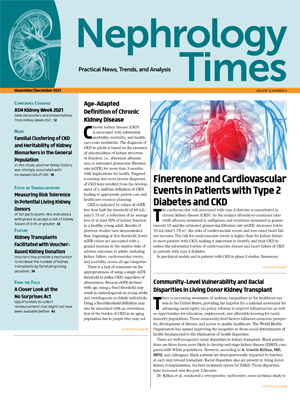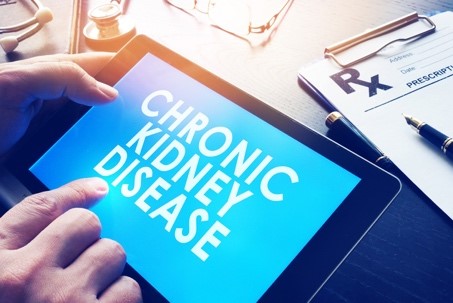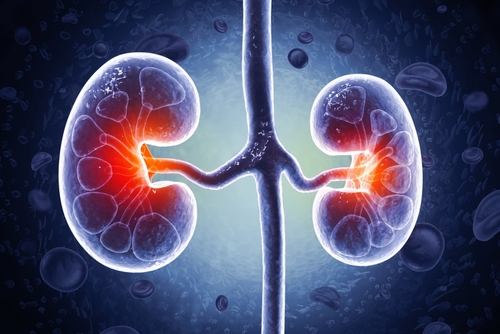
Chronic kidney disease (CKD) is associated with substantial morbidity, mortality, and healthcare costs worldwide. The diagnosis of CKD in adults is based on the presence of abnormalities of kidney structure or function, i.e., abnormal albuminuria or estimated glomerular filtration rate (eGFR) for more than 3 months, with implications for health. Targeted screening and more precise diagnoses of CKD have resulted from the development of a uniform definition of CKD, leading to appropriate patient care and healthcare resource planning.
CKD is indicated by values of eGFR less than half the threshold of 60 mL/min/1.73 m2, a reflection of an average loss of at least 50% of kidney function in a healthy young adult. Results of previous studies have demonstrated that, beginning at this threshold, lower eGFR values are associated with a graded increase in the relative risks of adverse outcomes in adults, including kidney failure, cardiovascular events, and mortality across all age categories.
There is a lack of consensus on the appropriateness of using a single eGFR threshold to define CKD, regardless of albuminuria. Because eGFR declines with age, using a fixed threshold may result in underdiagnosis in young adults and overdiagnosis in elderly individuals. Using a fixed-threshold definition may also be associated with an overestimation of the burden of CKD in an aging population due to people who may not have increased risks of adverse outcomes. Researchers have proposed an age-adapted CKD definition, with eGFR thresholds of 75, 60, and 45 mL/min/1.73 m2 for those younger than 40 years, those 40 to 64 years, and those 65 years and older, respectively.
Ping Liu, PhD, and colleagues conducted a population-based cohort study to identify adults with incident CKD according to the fixed-threshold and the age-adapted threshold definitions. The researchers sought to estimate incidence rates of CKD and the risks of kidney failure and death. They also compared the risks in people ≥65 years of age with normal to mild albuminuria who were diagnosed with CKD based only on the fixed-threshold definition (index eGFR, 45-59 mL/min/1.73 m2) with a control group with similar characteristics who did not have CKD (sustained eGFR, 60-89 mL/min/1.73 m2). Results were reported online in JAMA Internal Medicine [doi:10.1001/jamainternmed.2021.4813].
The study was conducted in Alberta, Canada, and utilized linked administrative and laboratory data from adults with incident CKD from April 1, 2009, to March 31, 2017. CKD was defined as a sustained reduction in eGFR for longer than 3 months below a fixed or age-adapted eGFR threshold. Controls without CKD were ≤65 years of age with a sustained eGFR of 60 to 80 mL/min/1.73 m2 for longer than 3 months and normal/mild albuminuria. Follow-up continued until March 31, 2019. Data analysis was conducted from February to April 2020.
The primary outcome of interest was the earlier of kidney failure or all-cause mortality, which were treated as competing events. Kidney failure was defined as the earlier of the initiation of kidney replacement therapy (chronic dialysis or kidney transplantation) or a sustained eGFR of less than 15 mL/min/1.73 m2 for more than 90 days.
The fixed-threshold cohort included 127,132 adults with incident CKD and the age-adapted threshold cohort included 81,209 adults with incident CKD. The incidence rate of CKD was 60% higher using the fixed-threshold definition compared with the age-adapted threshold (537 vs 343 new cases per 100,000 person-years). Among individuals ≥65 years of age, the rate differences were more pronounced: age 65-79 years, 2356 vs 714 per 100,000 person years; ≥80 years, 3767 vs 2597 per 100,000 person years. Among individuals <40 years of age, the age-adapted threshold definition yielded an 85% lower incidence rate (14 vs 91 per 100,000 person-years).
The fixed-threshold cohort was older, had a higher index eGFR, and was less likely to have moderate-to-severe albuminuria at baseline compared with the age-adapted cohort (20% vs 25% in the fixed-threshold cohort), those in older groups were more likely to have normal/mild albuminuria (33%, 72%, and 77% for age <40, 40-64, and ≥65 years, respectively). In the age-adapted cohort, the opposite was observed (74%, 72%, and 67%, respectively).
A total of 53,906 adults were included in both cohorts. Of those, 69% (n=37,018) were captured by both definitions on the same day, 30% (n=16,157) were captured a median of 1.9 years earlier by the fixed-threshold definition, and 1% (n=731) were captured a median of 1.4 years earlier by the age-adapted definition.
Of the fixed-threshold cohort members, 72,703 did not have CKD according to the age-adapted definition (57.2%). Of those, 74.7% (n=54,342) were ≥65 years of age and had an index eGFR of 45 to 59 mL/min/1.73 m2 with normal/mild albuminuria at baseline; 41.1% (n=30,093) had neither diabetes or cardiovascular disease. People who met the age-adapted definition only were <40 years of age at the start of the qualifying period.
The non-CKD elderly control group included 90,393 people ≥65 years of age with a sustained eGFR of 60 to 89 mL/min/1.73 m2 with mild/normal albuminuria.
In the fixed-threshold cohort, the risks of kidney failure and death at 5 years were 1.7% and 21.9%, respectively. The corresponding risks in the age-adapted cohort were 3.0% and 25.4%.
Among those with an index eGFR of 15 to 44 mL/min/1.73 m2, there was an association between lower eGFR and higher absolute risks of adverse outcomes, regardless of age. Most elderly people who entered the fixed-threshold cohort had an index eGFR of 45 to 59 mL/min/1.73 m2. Among that group, the 5-year absolute risk of kidney failure was similar in magnitude (≤0.12%) to that seen in people without CKD (eGFR 60-89 mL/min/1.73 m2) across age categories. Their 5-year absolute risk of death was also comparable across age categories (eGFR, 45-59 mL/min/1.73 m2: 8.3% vs 6.1% and 37.4% vs 40.8% for age 65-69 years and ≥80 years, respectively).
Study limitations cited by the authors included the study source population being predominately White, the study population was based on current guideline recommendations for calculation of eGFR, and the possibility that the study duration was insufficient for kidney failure and mortality outcomes in younger participants.
In conclusion, the researchers said, “This population-based study suggests that current eGFR criteria for CKD that do not account for age-related eGFR decline may result in overestimation of the CKD burden in an aging population. The excess incidence of CKD with current eGFR criteria is largely explained by elderly people who have an eGFR of 45 to 59 mL/min/1.73 m2 and normal/mild albuminuria. These people have a much higher absolute risk of death than kidney failure, and their risks of kidney failure and death are similar in magnitude to people of the same age who do not have CKD. These risk profiles suggest that an eGFR of 45 to 50 mL/min/1.73 m2 without albuminuria in elderly individuals may deserve recognition and management strategies to target modifiable risk factors for death but may not have implications for kidney health.”
Takeaway Points
- Researchers conducted a population-based cohort study to compare outcomes associated with chronic kidney disease as defined by a fixed versus an age-adapted estimated glomerular filtration rate (eGFR) threshold.
- The 5-year risks of kidney failure and death were lower in the fixed-threshold cohort compared with the age-adapted cohort (1.7% vs 3.0% and 21.9% vs 25.4%, respectively).
- In elderly people, the 5-year risks of kidney failure and death were similar to those of non-CKD controls.







 © 2025 Mashup Media, LLC, a Formedics Property. All Rights Reserved.
© 2025 Mashup Media, LLC, a Formedics Property. All Rights Reserved.